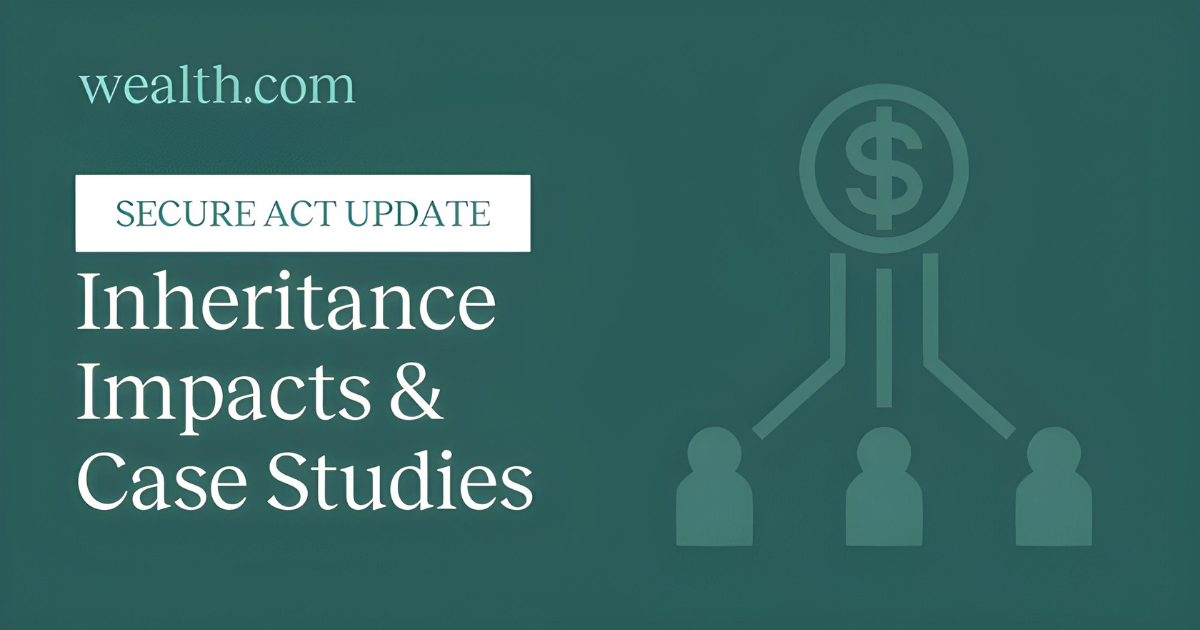This is the second part in a series about the SECURE Act and how it may affect estate plans
Last week we shared that the IRS had issued their final regulations to many provisions within 2019’s SECURE Act. Many of these directly impact those that intend to leave retirement accounts to their family as well as those that are set to inherit them—in some cases, those that already have inherited retirement accounts.
In this article, we dive a little deeper into potential scenarios of how these regulations could affect those inheriting 401(k)s or IRAs.
First, what was the old way?
Prior to 2020, under the old rules anyone that inherited a retirement account could take withdrawals over their life expectancy. Many viewed that as much more straightforward, created less urgency (if you expected to live more than 10 years) and typically provided more tax deferral opportunities (again, you could spread it out longer than 10 years).
Anytime a new tax rule is introduced, it’s bound to cause some confusion about who’s affected, who’s not and what happens in certain edge cases. But these new regulations create a lot more potential branches of who’s affected—and how—that is likely to create queastions and impact how financial planners advise their clients on their estate and tax plans.
Why was the stretch-rule changed?
As for why the 10-year rule was introduced by the SECURE Act, there are a few reasons, namely:
1. To increase tax revenue.
By decreasing withdrawals to 10-years (or less) means the government accelerates the tax revenue from those accounts.
2. Limiting retirement accounts as inheritance tools.
The stretch-strategy was often used by high-net-worth individuals in order to pass their wealth to their heirs while minimizing tax liability. The 10-year-rule puts limitations on retirement accounts as wealth transfer vehicles in the hopes of them being used for retirement savings as they were intended.
There are more retirement account-related changes as a result of the enactment of the SECURE Act, but, for now, we’re focusing on the impact of the 10-year-rule and the required minimum distributions (RMDs).
Here are some scenarios on how these updated regulations would impact them.
Scenario 1: Adult child inherits his father’s IRA who passed at 75
When Bill’s father passed away at the age of 75 in 2024, Bill inherited his father’s IRA. Given his father’s age, he had already begun taking RMDs, as required by the IRS rules. Under the SECURE Act, Bill is subject to the 10-year rule, meaning he must fully distribute the IRA account he inherited within 10 years of his father’s death. Additionally, in accordance with the recently issued IRS final regulations, he must also continue taking RMDs his father started withdrawing, with the amount based on his life expectancy.
That said, Bill has some strategic considerations and flexibility, depending on several factors, including his income, tax bracket and financial needs.
Option 1: Spread out withdrawals
While he needs to continue annual RMDs, he could increase his withdrawals to evenly spread out distributions across 10 years—assuming the RMDs are lower than this amount would need to be. This could help him avoid being pushed into a higher tax bracket due to withdrawing large lump sums.
Option 2: Delay withdrawals
If Bill expects his income to decrease before the 10-year window closes, he could delay taking larger distributions until later in the window. This would allow him to potentially reduce his overall tax burden.
Option 3: Immediate withdrawals
A common saying in financial planning is “don’t let the tax tail wag the dog.” If Bill has immediate financial needs, he could withdraw larger amounts sooner. This could have high potential tax implications but as long as Bill is aware, that may not be his biggest concern.
Scenario 2: Husband inherits his wife’s 401(k) who passed before 59.5
Ryan’s wife Emma passed unexpectedly at 55 and he was named sole beneficiary on her 401(K). Because Emma hadn’t reached the age of 59.5, when she would be able to start withdrawing from her 401(k) without penalty, and because she didn’t reach the age of requirement for RMDs—73—Ryan has a couple of options.
Option 1: Keep it as an inherited 401(k)
Ryan could choose to leave Emma’s 401(k) in the inherited account. This would allow him to access the funds without the 10% early withdrawal penalty, which is significant because Ryan is also under 59.5 years of age.
While this option would give Ryan immediate access to the funds, should he need it, he would need to start taking RMDs once Emma would have reached her required beginning date. It is important to consider that keeping the account in an inherited IRA (rather than rolling it to his own IRA) may mean the account is more susceptible to creditor claims.
Option 2: Roll over to his own IRA
Ryan could decide to roll over the inherited 401(k) into his own IRA. The benefit of doing so would allow him to delay taking RMDs until he reaches the age of 73. However, he would be subject to the 10% early withdrawal penalty until he reaches 59.5.
If he doesn’t foresee himself needing the funds until he reaches that age, this strategy could be beneficial for long-term growth since the funds would remain invested and grow tax-deferred for a longer period of time.
Strategic considerations
Ryan might also consider his overall tax situation. Taking RMDs from the inherited IRA will increase his taxable income each year, potentially pushing him into a higher tax bracket. By contrast, rolling the IRA into his own account defers this tax impact until he begins taking RMDs at age 73.
Additionally, if Ryan has other sources of income and doesn’t need the inherited IRA funds for living expenses, he might prefer the rollover option. This would give him more control over his retirement planning and potentially reduce his tax burden in the short term.
Scenario 3: Minor inherits a parent’s IRA
Sarah passed away at 68 and named her minor son, Jake, who is 15-years old, as the sole beneficiary of her IRA. Given her age, Sarah was not yet required to withdraw RMDs. Since Jake is a minor, he qualifies for an exception to the 10-year rule. This exception allows him to stretch out RMDs—calculated based on his own life expectancy—until he reaches the age of 21. During that time, he (or his guardian) will be required to withdraw annual RMDs to avoid penalties. Given his age, however, those RMDs are likely to be lower compared to an adult beneficiary.
When Jake turns 21, the stretch period ends, and he will be subject to the 10-year rule.
Scenario 4: Parent dies, adult child inherits, then adult child dies and adult grandchild inherits
When Mark passed away at the age of 75, his daughter, Lisa, inherited his IRA. Since Mark had already started taking RMDs, Lisa will be subject to RMDs and the 10-year rule.
Similar to Ryan in Scenario 2, her strategic considerations include spreading out withdrawals across the 10 years, delaying larger withdrawals or taking larger withdrawals sooner. What she decides to do depends on her financial situation, including her financial needs and tax strategy.
Unfortunately, Lisa passed away only a few years after Mark, leaving the IRA to her now adult child, Jane.
Jane is now subject to the 10-year rule but it would not restart. Meaning, she would have to continue the 10-year period that her mother, Lisa, already started. So if Jane passed during year 3 of her 10-year window, Lisa would be continuing that timeline and would need to fully distribute the IRA 7 years after she inherited it.
Scenario 5: Post-73 death, leaving IRA to a trust
Nancy passed away at 75 and left her IRA to a trust. How this scenario is handled depends on the type of trust, and the SECURE Act’s rules would guide how the IRA is distributed to the trust beneficiaries. The rules provide guidance on whether the trust is a “see-through” trust or not.
To be considered a “see-through” trust it must meet certain criteria, just as the term suggests—the beneficiaries must be identifiable. If the trust document doesn’t identify the beneficiaries, it could face more restrictive distribution rules.
Another piece of criteria is that the trust document must be delivered to the IRA custodian by October 31 of the year following Nancy’s death. This is so that the custodian can verify the trust terms and determine the appropriate distribution rules. Finally, it also depends on the trust type, whether it’s irrevocable or revocable.
For this scenario, let’s assume Nancy’s trust is considered “see-through” and is a revocable trust that becomes irrevocable at her death. The trust also names her two children, Alice and James, as equal beneficiaries. Neither Alice nor James are a minor or disabled to meet a SECURE Act exception permitting them to “stretch” distributions.
Both Alice and James are subject to the 10-year rule, and, therefore, the trust is likely subject to the same distribution rules.
Moving forward with inherited retirement accounts
These are just a few possible scenarios that are affected by the SECURE Act, so it’s important that financial advisors take the time to understand the nuances and intricacies for their clients. It also presents potential opportunities for advisors to help their clients with potential estate and tax strategies.
At wealth.com, we’re committed to staying on top of legislation that could impact estate planning strategies and will always ensure our advisors and clients are informed.
This post is one in a series of posts that will detail more aspects of the SECURE Act and the Treasury regulations. To stay up-to-date, follow wealth.com on LinkedIn or X/Twitter to get the latest on how these new regulations may impact your clients, their retirement accounts and their estate plans.



